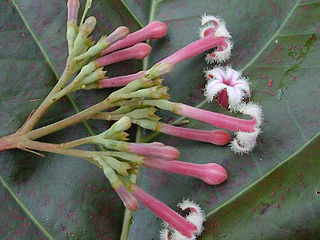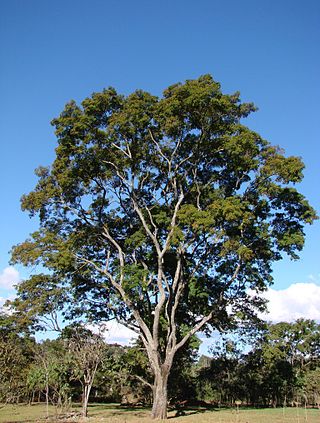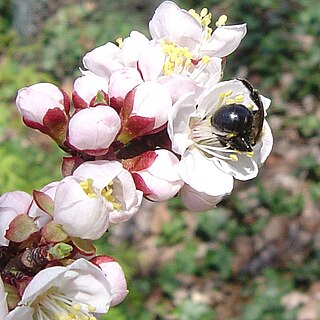
Ayahuasca is a South American psychoactive brew, traditionally used by Indigenous cultures and folk healers in Amazon and Orinoco basins for spiritual ceremonies, divination, and healing a variety of psychosomatic complaints. Originally restricted to areas of Peru, Brazil, Colombia and Ecuador, in the middle of 20th century it became widespread in Brazil in context of appearance of syncretic religions that uses ayahuasca as a sacrament, like Santo Daime, União do Vegetal and Barquinha, which blend elements of Amazonian Shamanism, Christianity, Kardecist Spiritism, and African-Brazilian religions such as Umbanda, Candomblé and Tambor de Mina, later expanding to several countries across all continents, notably the United States and Western Europe, and, more incipiently, in Eastern Europe, South Africa, Australia, and Japan.

The Moraceae — often called the mulberry family or fig family — are a family of flowering plants comprising about 38 genera and over 1100 species. Most are widespread in tropical and subtropical regions, less so in temperate climates; however, their distribution is cosmopolitan overall. The only synapomorphy within the Moraceae is presence of laticifers and milky sap in all parenchymatous tissues, but generally useful field characters include two carpels sometimes with one reduced, compound inconspicuous flowers, and compound fruits. The family includes well-known plants such as the fig, banyan, breadfruit, jackfruit, mulberry, and Osage orange. The 'flowers' of Moraceae are often pseudanthia.

Cinchona is a genus of flowering plants in the family Rubiaceae containing at least 23 species of trees and shrubs. All are native to the tropical Andean forests of western South America. A few species are reportedly naturalized in Central America, Jamaica, French Polynesia, Sulawesi, Saint Helena in the South Atlantic, and São Tomé and Príncipe off the coast of tropical Africa, and others have been cultivated in India and Java, where they have formed hybrids.

Liquorice or licorice is the common name of Glycyrrhiza glabra, a flowering plant of the bean family Fabaceae, from the root of which a sweet, aromatic flavouring is extracted.

Anadenanthera colubrina is a South American tree closely related to yopo, or Anadenanthera peregrina. It grows to 5–20 m (16–66 ft) tall and the trunk is very thorny. The leaves are mimosa-like, up to 30 cm (12 in) in length and they fold up at night. In Argentina, A. colubrina produces flowers from September to December and bean pods from September to July. In Brazil A. colubrina has been given "high priority" conservation status.
The name Catuaba is used for the infusions of the bark of a number of trees native to Brazil. The most widely used barks are derived from the trees Trichilia catigua and Erythroxylum vaccinifolium. Other catuaba preparations use the bark of trees from the following genera or families: Anemopaegma, Ilex, Micropholis, Phyllanthus, Secondatia, Tetragastris and species from the Myrtaceae.

Barringtonia acutangula is a species of Barringtonia native to coastal wetlands in southern Asia and northern Australasia, from Afghanistan east to the Philippines, Queensland and the Northern Territory. Common names include freshwater mangrove, itchytree and mango-pine.

Inga edulis, known as ice-cream bean, ice-cream-bean, joaquiniquil, cuaniquilguama or guaba, is a fruit native to South America. It is in the mimosoid tribe of the legume family Fabaceae. It is widely grown, especially by Indigenous Amazonians, for shade, food, timber, medicine, and production of the alcoholic beverage cachiri. It is popular in Peru, Ecuador, Pernambuco-Brazil, Venezuela and Colombia. The taxonomic name Inga is derived from its name with the Tupí people of South America (ingá) while the species name edulis is Latin for "edible". The common name "ice-cream bean" alludes to the sweet flavor and smooth texture of the pulp.

Antiaris toxicaria is a tree in the mulberry and fig family, Moraceae. It is the only species currently recognized in the genus Antiaris. The genus Antiaris was at one time considered to consist of several species, but is now regarded as just one variable species which can be further divided into five subspecies. One significant difference within the species is that the size of the fruit decreases as one travels from Africa to Polynesia. Antiaris has a remarkably wide distribution in tropical regions, occurring in Australia, tropical Asia, tropical Africa, Indonesia, the Philippines, Tonga, and various other tropical islands. Its seeds are spread by various birds and bats, and it is not clear how many of the populations are essentially invasive. The species is of interest as a source of wood, bark cloth, and pharmacological or toxic substances.
Ficus maxima is a fig tree which is native to Mexico, Central America, the Caribbean and South America south to Paraguay. Figs belong to the family Moraceae. The specific epithet maxima was coined by Scottish botanist Philip Miller in 1768; Miller's name was applied to this species in the Flora of Jamaica, but it was later determined that Miller's description was actually of the species now known as Ficus aurea. To avoid confusion, Cornelis Berg proposed that the name should be conserved for this species. Berg's proposal was accepted in 2005.

Cannabaceae is a small family of flowering plants, known as the hemp family. As now circumscribed, the family includes about 170 species grouped in about 11 genera, including Cannabis (hemp), Humulus (hops) and Celtis (hackberries). Celtis is by far the largest genus, containing about 100 species.

Licochalcone A is a chalconoid, a type of natural phenol. It can be isolated from the root of Glycyrrhiza glabra (liquorice) or Glycyrrhiza inflata. It shows antimalarial, anticancer, antibacterial and antiviral properties in vitro.

Croton lechleri is a species of flowering plant in the spurge family, Euphorbiaceae, that is native to northwestern South America. It is commonly known as sangre de grado, sangre de drago or sangre de grada. They refer to this tree's thick red latex.

Brunfelsia grandiflora is a flowering shrub in the nightshade family. It is native to South America. In English is known by the common names royal purple brunfelsia, kiss-me-quick, and yesterday-today-and-tomorrow. In Peru it is known by the Spanish-Quechua name chiricsanango.

Calycophyllum spruceanum, common names capirona and Pau-Mulato, is a canopy tree belonging to the Gardenia Family (Rubiaceae) indigenous to the Amazon rainforest. Its most interesting characteristic is its very shiny, highly polished green bark. The oblong leaves are up to seven inches in length. The white flowers are in small terminal clusters.
Phthirusa pyrifolia is a subtropical flowering plant species of the family Loranthaceae. It grows in forests from Mexico through Central America, Peru, Bolivia, and Brazil. It flowers and fruits year-round; its small berries range in color from orange to deep red when ripe.

Prunus mandshurica, also called Manchurian apricot and scout apricot, is a tree in the genus Prunus.
Acaté Amazon Conservation is a non-profit organization founded in 2012 by physician-ethnobotanist Christopher Herndon, M.D. and sustainable agriculturist William Park. Acaté Amazon Conservation works with the indigenous people of the Peruvian Amazon to help protect the Amazon rainforest while providing the indigenous people economic opportunities. Notable initiatives include permaculture methods for sustainable agriculture, generating income through renewable non-timber resources as well as preservation of traditional knowledge and culture.

Morus mongolica, also described as Morus alba var. mongolica, is a woody plant native to mountain forests in Mongolia, China, Korea, and Japan. Common names include Mongolian mulberry, meng sang (China), and ilama by native people in the namesake region of Mongolia. Similar to M. notabilis, M. mongolica is an uncultivated mulberry.

Bauhinia glabra, also commonly referred to as the monkey step/ladder, is more often introduced with its accepted name, whereas Bauhinia cumanensis, is a synonym for the plant name. B. glabra is located in the tropical climates of countries such as Venezuela, Trinidad and Tobago, Ecuador, Brazil, Costa Rica, Colombia and Guayana, while being introduced to Sri Lanka.















